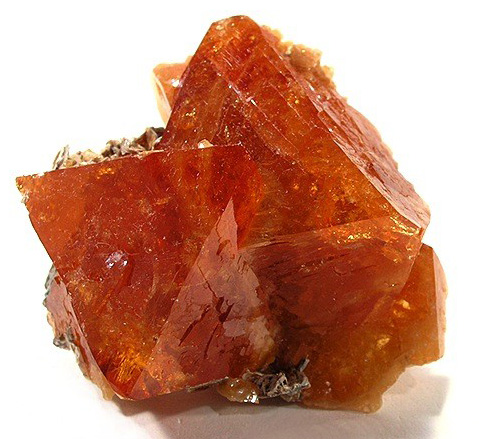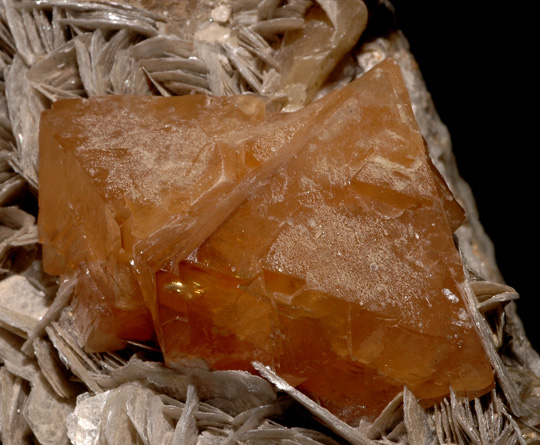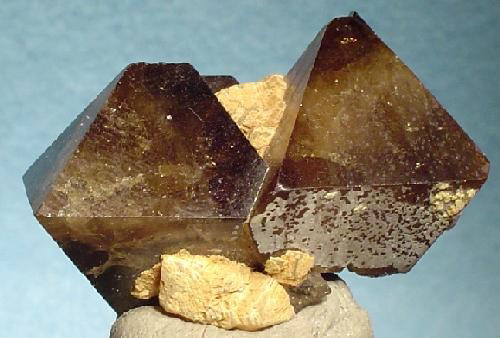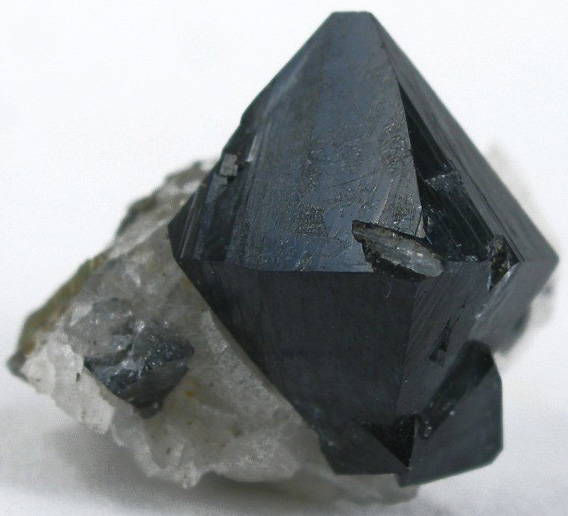Scheelite
Scheelite is a calcium tungstate mineral. It has the chemical formula CaWO4 and is the most important tungsten ore. [1] Scheelite crystals can occur in a wide variety of colors, including colorless, white, gray, brown, orange and dark blue/black, and these can sometimes be large, weighing a pound or more.

Scheelite
Photo by Rob Lavinsky, iRocks.com - image lic. under CC-BY-SA-3.0
Scheelite sometimes forms fine crystals, and these are desirable to mineral collectors owing to their interesting tetragonal dipyramidal shape, and variety of colors. Some scheelite crystals are transparent and these have on occasion been faceted into gemstones; though scheelite gemstones are much less likely to be seen than scheelite crystals in the natural state.
In addition to the dipyramidal "pseudo-octahedra" already mentioned, scheelite can also occur in columnar, granular, tabular or massive habit. Scheelite has also been found in the form of druze ( a "carpet" of tiny crystals) in the Czech Republic. [1]
Scheelite was named after Karl Wilhelm Scheele (1742-1786), a Swedish scientist who demonstrated the presence of tungsten in the stone in 1781. [2]
One of scheelite's well known qualities is that it will exhibit strong blue fluorescence under short wave UV light, but almost none under long wave UV. This phenomenon has enabled prospectors to search for scheelite using UV light, even finding it in mines which had previously been considered exhausted.[2] Miners looking for scheelite nowadays use ultraviolet lamps.
Scheelite is somewhat soft (4.5-5.0 Mohs) and so is not ideally suited to jewelry settings, as it may be too easily damaged. Scheelite gemstones are more often seen loose, in colored gemstone collections. Despite their rarity, scheelite gemstones are relatively inexpensive - and in March 2011 I observed a 17.3 carat oval-cut transparent scheelite gemstone priced at $660 - which works out to just over $38 per carat. In general, scheelite gemstones seem to be pried between $10 and $100 per carat, with most of the cut stones being in the yellow-orange-brown range of colors. The largest cut scheelite I have seen for sale is 36.2 carat.
Scheelite occasionally displays asterism - the phenomenon of a "star" of light appearing within the stone, due to the presence of micro-fine fibres of rutile within the mineral. In the case of scheelite, the star seen has four rays. Star scheelite is however considered a very rare gem and has been found in Sri Lanka.
Other scheelites have been found to display chatoyance, literally "cat eye-ness". This effect is also caused by very fine hair-like mineral inclusions in the stone, or by a fibrous quality to the rock itself. In instances of chatoyance the inclusions / fibres all run in the same direction - and reflect a beam of light in a perpendicular direction. Like asterism, the effect is best displayed by cutting the stone en cabochon, which will cause the reflection of light to "move" within the stone as it is moved.
Scheelite has been found in association with numerous minerals, including cassiterite, wolframite, epidote, topaz, fluorite, apatite, tourmaline, quartz, garnet, diopside, gold and silver. [3] [4] Scheelite's occurence is widespread, being found in many countries in the world and in over 3,000 locations in all. [5]
Scheelite is isostructural with powellite, CaMoO4, meaning that it has the same crystalline structure. These two minerals form a mineral series, with the amount of molybdenum and tungsten being variable. The presence of molybdenum is revealed by yellow fluorescence instead of blue. [4]
It is possible to make synthetic scheelite, and this material has been used in laser technology as a lasing medium. Synthetic scheelite was once used to imitate diamond. [1] Although it is soft, scheelite has high refractive index and dispersion, meaning that a well cut stone may have optical performance characteristics approaching those of diamond. However, its use as a diamond substitute has been superseded by other materials such as moissanite.
Scheelite Images

Scheelite
Scheelite crystals on mica matrix. From China.

Scheelite
Size: 3.3 x 2.3 x 2.2 cm. From South Korea.
Photo by Rob Lavinsky, iRocks.com - image lic. under CC-BY-SA-3.0

Scheelite
Size: 1.6 x 1.2 x 1.1 cm. From Romania. Shows deep, intense blue when backlit.
Photo by Rob Lavinsky, iRocks.com - image lic. under CC-BY-SA-3.0
Scheelite - Sources Referenced:
[1] http://en.wikipedia.org/wiki/Scheelite
[2] http://www.multicolour.com/scheelite.html
[3] http://www.handbookofmineralogy.org/pdfs/scheelite.pdf
[4] http://www.galleries.com/minerals/sulfates/scheelit/scheelit.htm
[5] http://www.mindat.org/min-3560.html
Back to the Gemstones List home page - over 160 gemstones explored!
Please feel free to link to this page - copy / paste the text below:
(click to select)
Privacy Policy | Cookie Policy | GDPR | About This Site / Terms

© gemstoneslist.com



